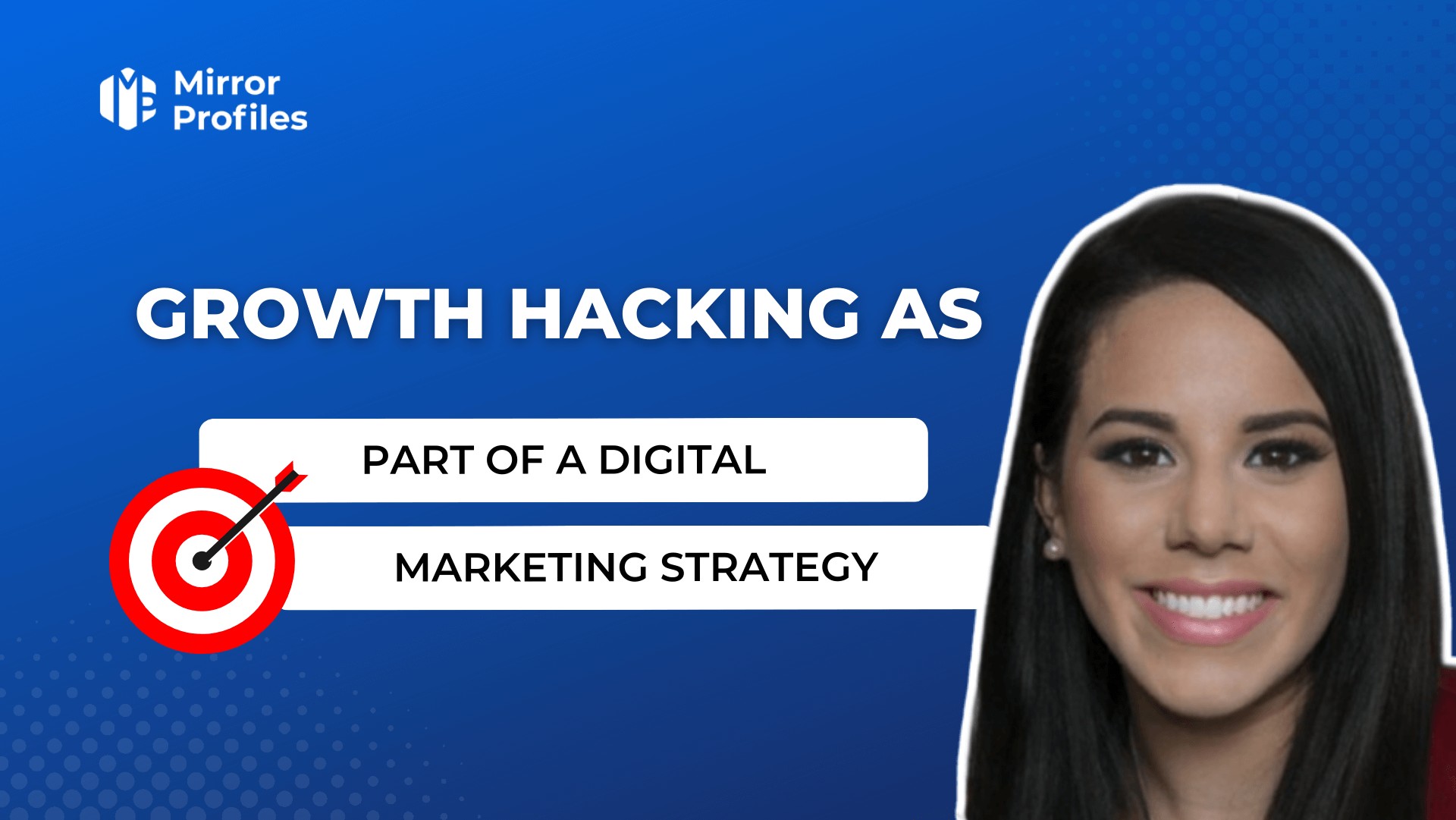Digital marketing encompasses a range of techniques for promoting a brand or product online, particularly via networks. In so doing, it aims to reach a wide audience, build customer loyalty and increase revenues. However, with ever-increasing competition and constantly evolving technologies, having a simple website or Facebook account is no longer enough. Today, an agile, creative and results-oriented approach is crucial. This is where growth hacking comes in.
Growth hacking is a digital marketing method focused on maximizing a company’s growth through automation, experimentation (or A/B testing), data studies, and the use of various marketing tactics. It’s based on the idea that customer growth is the main indicator of business success, encouraging the rapid exploitation of assumptions and web opportunities to maximize that growth. Although growth hacking is primarily aimed at start-ups seeking to gain visibility and customers on a limited budget, it is also beneficial for more mature companies looking to innovate and increase their user base.
This article will detail what growth hacking is, its origins, its importance in marketing, its benefits, successful examples of growth hacking strategies, and how to implement these data-driven strategies to boost your business. Ready to discover how growth hacking can drive your business growth and achieve better results? Enjoy your reading! 🙂
Definition and origins of Growth Hacking
What is Growth Hacking?
Growth hacking is a digital marketing method designed to accelerate a company’s growth by using innovative tactics to maximize profitability. This approach is based on the conviction that growth is the main indicator of a company’s success. With this in mind, it recommends validating hypotheses quickly and seizing digital opportunities without delay. Initially designed for start-ups seeking visibility and customers without substantial financial resources, growth hacking is also relevant for more mature businesses aiming to grow or secure their sales pipeline. This is particularly the case with the rental of fake LinkedIn profiles: you can equip your sales team with MirrorProfiles accounts, so that if a sales rep has to leave, they won’t take their LinkedIn network with them.
The birth of Growth Hacking
Sean Ellis, a consultant who has helped accelerate the growth of numerous startups such as Dropbox, coined the term growth hacking in 2010. Wishing to define those who drive business growth beyond traditional marketing methods, he described the growth hacker as “someone for whom growth is a compass”.
Their mission is to evaluate each stock according to its potential to generate significant and sustainable growth. Andrew Chen, a leading figure in digital marketing, has widely disseminated the concept of growth hacking, notably through his landmark article, “Growth Hacker is the new VP Marketing”, highlighting the example of Airbnb and its clever integration with Craigslist. Growth hackers distinguish themselves by their ability to combine marketing and computer programming to creatively address the fundamental objectives: how to attract more customers, increase user engagement, and drive sales. To achieve this, they rely on tools such as A/B testing, effective landing page design, virality, optimized messaging (email or LinkedIn), and Open Graph exploitation.
The role of Growth Hacking in digital marketing
Why integrate Growth Hacking into your marketing strategy?
Growth Hacking, a revolutionary approach to marketing strategy, focuses on rapidly optimizing business growth through innovative, cost-effective tactics. This method enables companies to stand out from their competitors in the online market, increase sales, and build a significant competitive advantage.
Ideally suited to startups looking to make a name for themselves and win users on a shoestring budget, Growth Hacking encourages rapid experimentation, effective evaluation of results, and maximum exploitation of the opportunities offered by the internet and social media platforms. What’s more, it helps develop products that truly meet consumer expectations, while stimulating word-of-mouth referrals and viral engagement.
How Growth Hacking will transform digital marketing in 2025
In 2025, Growth Hacking continues to transform the digital marketing landscape, highlighting the limitations of traditional marketing approaches – often costly, time-consuming, and ineffective. This trend favors a more agile, creative, and results-driven approach to marketing.
At the heart of Growth Hacking lies a unique combination of interdisciplinary skills encompassing marketing, software development, engineering, and product management. The Growth Hacker, a perfect hybrid of technician and marketer, uses a variety of tools including A/B testing, SEO, email marketing, social media marketing, content marketing, and web analytics. Thanks to their ability to innovate and think outside the box, Growth Hackers implement original, high-performance strategies to attract leads, activate users, retain customers, monetize audiences, and drive engagement.
The main benefits of Growth Hacking for digital marketing
Increased visibility and engagement
Growth hacking is an essential lever for boosting your company’s online presence and interaction on social media platforms. This technique focuses on creating a product perfectly aligned with users’ desires, while using original, viral content and media strategies to promote it. It’s a formidable tool for driving web traffic, increasing registrations, shares, comments, and reviews. Growth hacking also excels in the art of promoting word-of-mouth referrals and recommendations, essential tools for attracting new users and customers.
Ability to test and adapt quickly
With an approach based on experimentation, Growth Hacking offers the flexibility needed to adjust in the blink of an eye to market changes and customer expectations. This method involves formulating hypotheses, testing them through A/B testing and other tactics, studying the results, and refining strategies. It allows you to confirm or reject marketing strategies, identify the most effective ones, and implement them without delay. Growth hacking takes full advantage of the potential of the Internet and social media platforms, adapting or exploiting existing channels to drive business growth.
Automation and growth hacking are intimately linked, enabling businesses to test and adapt acquisition strategies rapidly. For example, our largest MirrorProfiles customers rent around a hundred LinkedIn accounts, so they have a colossal strike force to generate leads. They can contact over 10,000 people a week, enabling them to carry out a huge number of experiments quickly and on a large scale.
Reduce costs and increase ROI
Growth hacking also means reducing marketing costs and maximizing return on investment (ROI). It focuses on improving growth with limited resources, using tactics that are both economical and effective. This approach considerably lowers the costs associated with traditional marketing, which is often expensive and inefficient. Growth hacking also contributes to revenue growth by monetizing the audience, strengthening customer loyalty, and generating added value through targeted content and email campaigns.
Automation boosts lead generation by equipping the sales team and making them more efficient. I like to compare that to a traditional fisherman with a fishing rod versus a trawler. The fisherman will bring in fewer fish than the trawler, and it’s exactly the same if your sales force is equipped with growth hacking tools like MirrorProfiles. This process drives higher engagement and increases the number of leads efficiently.
Examples of successful Growth Hacking strategies
Airbnb: Create a viral effect with a bold Growth Hacking strategy
Airbnb, the world-famous platform for renting accommodation between private individuals, has employed a particularly bold growth hacking strategy to gain brand recognition and users: integration with Craigslist. Craigslist, a giant in the U.S. classifieds market, offers, among other things, vacation rentals. Airbnb has captured this massive audience by making it easy for hosts to publish their listings on Craigslist, with the added bonus of a direct link to their Airbnb profile. This tactic helped Craigslist visitors discover Airbnb and sign up for the platform. In addition, Airbnb automatically invited people posting rental offers on Craigslist to join Airbnb via email, promising greater visibility and security. Thanks to this tactic, Airbnb quickly expanded its brand awareness and user base without incurring significant advertising costs.
Dropbox: Leveraging referrals to accelerate growth
Dropbox, the well-known online file storage and sharing service, has come up with a simple but highly effective growth hacking strategy to accelerate its growth: the referral program. The concept is simple: offer free extra storage space to customers who invite their friends to sign up for Dropbox. This referral system encourages existing customers to promote Dropbox to their network, generating a viral effect and driving user engagement. Thanks to this program, Dropbox quadrupled its customer base in just 15 months, from 100,000 to 4 million. This recruitment method proved far more cost-effective than traditional ads, and also helped build customer loyalty by providing significant added value.
How to implement a Growth Hacking strategy in digital marketing
Define objectives and KPIs
To implement an effective growth hacking strategy in digital marketing, it’s crucial to start by clearly defining the objectives and key performance indicators (KPIs) needed to evaluate growth.
Objectives should follow the SMART principle, meaning they should be specific, measurable, achievable, realistic, and time-bound. A concrete example would be to aim for a 10% increase in the number of users over a 3-month period. As for KPIs, they should be chosen for their relevance, quantifiability, and easy accessibility, such as conversion rate, retention rate, or customer acquisition cost. Utilizing data-driven KPIs helps marketers achieve precise results and drive business growth.
Create, implement and test ideas
The next phase consists of creating, implementing, and testing growth hacking ideas to optimize growth. It is essential to adopt an experimental approach, embracing the “test and learn” method. This means generating a wide range of ideas, drawing on best practices, proven success stories, and your own creativity. It’s important to prioritize these ideas according to their potential for success, cost, and ease of implementation. They need to be implemented quickly and efficiently, using appropriate tools such as web analytics, SEO, email marketing, network marketing, and content marketing. These ideas are validated using test methods such as A/B testing, which compares the performance of different versions of the same idea, helping marketers determine the most effective tactics.
Analyze results and adjust strategy
The final stage involves analyzing the results obtained and adjusting the strategy accordingly. This involves assessing the impact of growth hacking actions in relation to the initially set objectives and KPIs. By examining the data collected, businesses can identify strengths, weaknesses, opportunities, and threats. Now it’s time to fine-tune the strategy, retaining successful initiatives, improving those with potential for enhancement, and discarding ineffective approaches. It’s essential to keep innovating, exploring new ideas, testing new distribution channels, and adapting swiftly to market changes and user needs to drive continuous growth.
Growth hacking, an inventive method of digital marketing, aims to rapidly stimulate business growth by employing tactics of experimentation, data mining, and automation. This approach offers a number of advantages: it allows you to stand out in a competitive market, increase customer loyalty, boost sales, and forge a distinct brand identity, driving sustained business growth.
Although growth hacking is particularly well-suited to startups, all businesses can (and should) benefit from it too. The profile of the growth hacker is unique, requiring mixed expertise in marketing, development, engineering, and product management, in order to design and execute innovative strategies that drive success and enhance customer engagement.
Given the notable successes of companies such as Airbnb and Dropbox, which have leveraged innovative and viral growth hacking techniques, incorporating this strategy into your digital marketing efforts shouldn’t be delayed. Our team of marketers is ready to support you in adopting growth hacking, to help you develop a product that meets your customers’ expectations, gain visibility using methods that are both effective and economical, and maximize your business growth. Take a MirrorProfiles demo and we’ll advise you on the right growth stack for your business.
FAQ
What are the 3 pillars of growth hacking?
The 3 essential pillars of growth hacking include:
Acquiring new users: This stage involves attracting as many leads as possible to the company’s website or application via cost-effective channels such as SEO, social media, email marketing, or word-of-mouth referrals.
User retention: This involves building customer loyalty by offering them an enriching user experience and responding effectively to their expectations, thanks to tools such as marketing automation, push notifications, or loyalty programs.
Increasing frequency of use: The aim here is to encourage users to make more frequent use of the product or service offered by the company through gamification, personalized offers, tailored recommendations, and engaging content.
How does growth hacking work?
Growth hacking is a strategic approach to rapidly boosting a company’s growth through innovative, cost-effective marketing techniques. This method relies on in-depth data analysis, agile experimentation, and the ability to generate virality to attract and retain a target clientele, driving sustained business growth.
What is the role of a Growth Hacker?
A Growth Hacker’s mission is to ensure the rapid, cost-controlled expansion of their business through inventive, high-impact digital marketing tactics. Their expertise lies in their ability to test, analyze, and fine-tune customer acquisition, conversion, and retention strategies, helping businesses achieve their growth objectives.
Who invented growth hacking?.
The concept of growth hacking, offering an innovative and cost-effective marketing approach to propel the growth of businesses, particularly startups, was created by Sean Ellis, an American entrepreneur and investor, and founder of GrowthHackers, in 2010.





